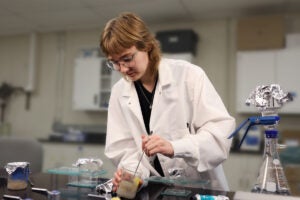Researchers at The University of Texas at Austin, in collaboration with the Ethiopian government, have completed the first high-resolution CT scan of the world’s most famous fossil, Lucy, an ancient human ancestor who lived 3.2 million years ago.
Lucy is in the United States as part of a world premiere exhibit organized by the Houston Museum of Natural Science.

John Kappelman, professor of anthropology in the College of Liberal Arts, led the scientific team that conducted the scan of Lucy, whose remains include about 40 percent of her skeleton, making her the oldest and most complete skeleton of any adult, erect-walking human fossil.
“By examining the internal architecture of Lucy’s bones, we can study how her skeleton supported her movement and posture, and compare that to modern humans and apes,” Kappelman said. “Because Lucy is so complete, she is one of the few fossils that permit us to compare how she used her arms versus how she used her legs. These new data will allow us to examine the theory that she climbed about in the trees, as well as walked on two legs when she was on the ground.”
Although Lucy is small (about one meter tall), her contribution to science has been large. She represents a distinct species of human ancestor, known as Australopithecus afarensis, or “southern ape of Afar,” in reference to where the bones were found.
Prior to the 1974 discovery of Lucy, some theories of evolution suggested human-like intelligence evolved before upright posture (bipedalism). But the existence of ancient bipeds like Lucy refutes this theory because their brain is not significantly larger than that of a modern chimpanzee.
The Ethiopian government entrusted Lucy to Kappelman and Richard Ketcham, associate professor of geological sciences in the Jackson School of Geosciences and director of the university’s High-Resolution X-ray Computed Tomography Facility, one of the world’s premier labs for this work.
Scientists at the facility have scanned thousands of delicate fossils and biological specimens, including irreplaceable items such as the brain case of Archaeopteryx (one of the oldest and most primitive birds known). Because CT allows scientists to see inside fossils without doing any harm, it has become one of the most powerful tools for studying precious, one-of-a-kind specimens.
“We have more experience scanning natural history objects and dealing with the issues that can arise in scanning natural material than any other lab in the world,” Ketcham said. “The equipment is constantly updated and we’ve created a large, specialized toolkit to process the scan data and to extract the maximum amount of information from it. There’s no other place the Ethiopian government could have sent Lucy to get better imagery or to acquire it more safely.”
For 10 days the university team worked around the clock to scan all 80 pieces of Lucy’s skeleton. The scientists created custom-built foam mounts to safely hold the specimens in the scanner. And each piece was carefully examined before and after scanning to ensure that no damage occurred during the project.

The successful completion of Lucy’s scan means that the specimen is now safely archived in digital format, another of the reasons behind the scanning.
“These scans will ensure that future generations are familiar with Lucy,” said Jara Mariam, director general of Ethiopia’s Authority for Research and Conservation of Cultural Heritage, “and will know of Ethiopia’s central contribution to the study of human evolution. A virtual Lucy will be able to visit every classroom on the planet.”
“In some ways, scanning Lucy was the easy part,” Ketcham said. For the next several months, the research team, consisting of scientists from all around the country, will be reviewing and processing the data and generating images to analyze Lucy’s skeleton and begin to answer important questions ranging from whether she climbed among the tree branches to how she chewed.
This ancient hominin, whom Ethiopians call “Dinkenesh” (“You are beautiful”), is the feature attraction in the exhibit, “Lucy’s Legacy: The Hidden Treasures of Ethiopia,” which is touring the United States. More than a quarter million people viewed the fossil at Houston Museum of Natural Science during 2007 and 2008. After the brief layover in Austin for the scan, Lucy moved to the Pacific Science Center in Seattle where she is on exhibit through March.
Kappelman said the university’s scanning project represents a model for future collaborations between public educational programs and scientific research.
“There is an understandable tension between museum curators, who like to display fossils, and scientists who want to conduct research on the specimens,” Kappelman said. “Our project demonstrates these goals are not mutually exclusive–but mutually beneficial. The museum exhibit that features Lucy offers a once in a lifetime opportunity to introduce millions of people to the actual evidence for human evolution, and seeing the real fossil is so much more meaningful than viewing a plastic replica.”
“Having Lucy here also means that scientists can conduct research that asks new questions about the fossil and this knowledge feeds back into the ongoing exhibit and continues to educate,” Kappelman said. “Lucy may be old, but she still has lots of new secrets to tell.”
CONTACTS AND IMAGES
The scientific team includes:
John Kappelman, Ph.D.
Department of Anthropology
The University of Texas at Austin
Austin, TX 78712
Phone: 512-471-0055
Email: jkappelman@mail.utexas.edu
Richard Ketcham, Ph.D.
Department of Geological Sciences, Jackson School of Geosciences
The University of Texas at Austin
Austin, TX 78712
Phone: 512-471-6942
Email: ketcham@mail.utexas.edu
Robert Fajardo, Ph.D.
Orthopedic Biomechanics Laboratory
Beth Israel Deaconess Medical Center
Harvard Medical School
Boston, MA 02215
Phone: 617-667-4572
Email: rfajardo@bidmc.harvard.edu
Brian G. Richmond, Ph.D.
Center for the Advanced Study of Hominid Paleobiology
Departments of Anthropology, and Anatomy and Regenerative Biology
The George Washington University
Washington, DC 20052
Phone: 202-994-0873
Email: brich@gwu.edu
Christopher Ruff, Ph.D.
Center for Functional Anatomy and Evolution
Johns Hopkins University School of Medicine
Baltimore, MD 21205
Phone: 410-955-7126
Email: cbruff@jhmi.edu
Robert S. Scott, Ph.D.
Department of Anthropology and Center for Human Evolutionary Studies
Rutgers, The State University of New Jersey
New Brunswick NJ 08901-1414
Phone: 732-932-6760
Email: robertsc@rci.rutgers.edu



